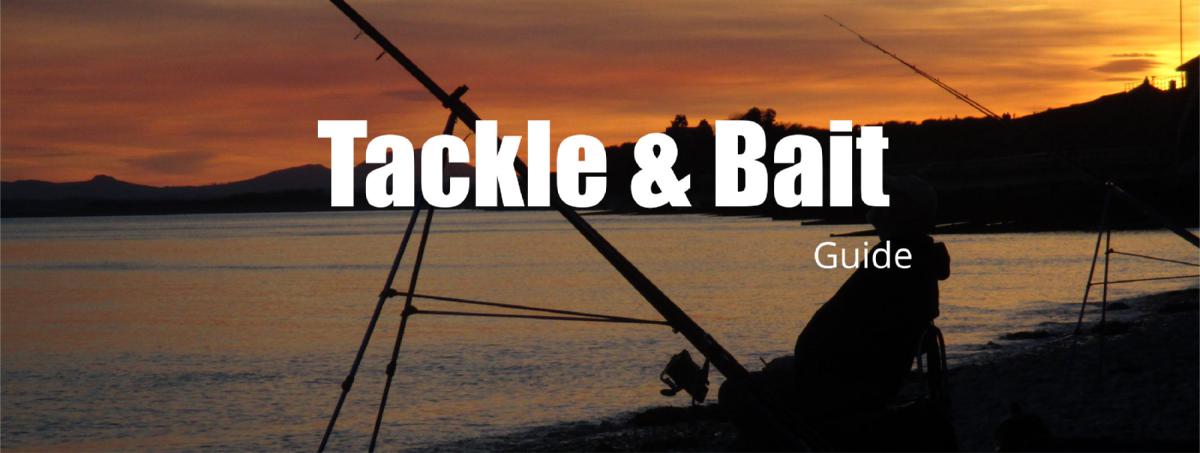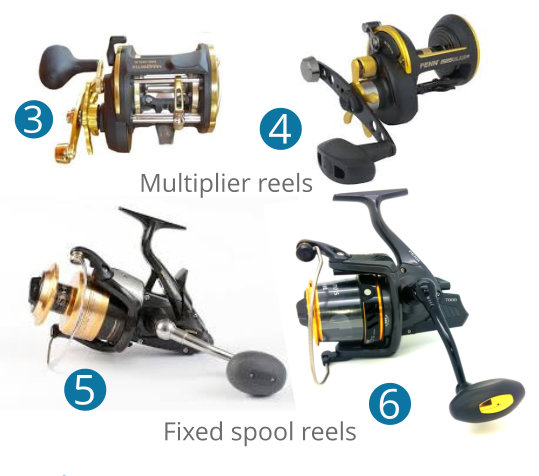
Rods and Reels
Last Updated October 2022


Beach Casting Rods
1 Multiplier Rods - These have more eyes (line guides) and smaller diameter eyes than a fixed spool rod. The additional eyes are to ensure the line doesn’t flat against the rod when the it is loaded. The smaller eyes are are used because of the way line is delivered from a multiplier. The line comes straight off the reel and is not coiled as it si with a fixed spool reel.
2 Fixed Spool Rods - These have less eyes as the reel is fished down (below the rod) and the line moves away from the blank when it loads. The eyes are also a larger diameter. This is to avoid the coils of line snagging during a cast.
Which rod is best?
At one time fixed spool reels and rods didn’t offer the same capability for distance casting as multiplier reels. So multiplier rods and reels were where development was concentrated and they became the mainstay in any serious beach anglers armoury.
It’s no longer the case with today’s with vastly improved ‘Continental’ style rods of 15ft or more.
The Continental style rod and fixed spool set up is far easier for novice (or coarse) angler to use. A further consideration is the size of rod sections. A typical 3 piece continental rod is far easier to fit in the car. Multiplier rods are normally 2 piece so each section is longer.

Reels
3 & 4 Multiplier Reels - Not as easy to use as a fixed spool but offers many advantages. They are lighter than fixed spool reels, smaller than fixed spool reels. They are lower geared than a fixed spool reel and this gives them a much better crane-like lifting capability. Try winding a smallish dogfish 20ft up a quayside using a fixed spool reel and you’ll see the difference. However they don’t suffer fools lightly and can be a nightmare for a novice with their infamous ability to overrun. They allow heavy lines to be used with very little loss of casting distance.
5 & 6 Fixed Spool Reels - Very user friendly and easy to use. Modern fixed spool reels cast well have a great retrieve rate. They will allow leads to rise up high in the water due to the retrieve rate which helps avoid rocks or weed closer to the shore. Not as good with heavier mono lines as the spool empties the friction of line on the lip of the spool increases. Many people now use braid on their fixed spool reels to counter this.
3 & 4 Multiplier Reels - Not as easy to use as a fixed spool but offers many advantages. They are lighter than fixed spool reels, smaller than fixed spool reels. They are lower geared than a fixed spool reel and this gives them a much better crane-like lifting capability. Try winding a smallish dogfish 20ft up a quayside using a fixed spool reel and you’ll see the difference. However they don’t suffer fools lightly and can be a nightmare for a novice with their infamous ability to overrun. They allow heavy lines to be used with very little loss of casting distance.
5 & 6 Fixed Spool Reels - Very user friendly and easy to use. Modern fixed spool reels cast well have a great retrieve rate. They will allow leads to rise up high in the water due to the retrieve rate which helps avoid rocks or weed closer to the shore. Not as good with heavier mono lines as the spool empties the friction of line on the lip of the spool increases. Many people now use braid on their fixed spool reels to counter this.
Can I use freshwater rods and reels for sea fishing?
A frequent question which crops up on a regular basis on many of the dedicated 'Sea Angling' facebook groups.
The answer is yes certainly carp style rods and ledger rods. Both can be used for light shore fishing, estuary fishing or float fishing from rocks, harbours or breakwaters.
I often use a 3lb test curce carp rod when the location and conditions allow. If you choose the smaller neap tides as opposed to the larger spring tides and fish in fairly settled conditions you should find fishing lighter gear very rewarding.
The softer rods are well suited to casting 90g weights and fishing delicated baits. The stiffer beach rods can be too powerful for baits such as harbour rag and even blow lug resulting in them breaking up during the cast.
A carp rod makes an excellent float fishing rod for the sea!
As with any form of fishing being in the right place, at the right time, with the right bait is your best bet. The fish don't care what rod and reel your using!
Lure fishing is becoming very popular. For this a freshwater spinning rod capable of handling the weight of the lure is perfect.
Just remember to wash your coarse fishing rods and reels down with clean tap water after using them in the sea. Fresh water rods and reels are not a good mix with sea water especially if put away without a rinse down!
A frequent question which crops up on a regular basis on many of the dedicated 'Sea Angling' facebook groups.
The answer is yes certainly carp style rods and ledger rods. Both can be used for light shore fishing, estuary fishing or float fishing from rocks, harbours or breakwaters.
I often use a 3lb test curce carp rod when the location and conditions allow. If you choose the smaller neap tides as opposed to the larger spring tides and fish in fairly settled conditions you should find fishing lighter gear very rewarding.
The softer rods are well suited to casting 90g weights and fishing delicated baits. The stiffer beach rods can be too powerful for baits such as harbour rag and even blow lug resulting in them breaking up during the cast.
A carp rod makes an excellent float fishing rod for the sea!
As with any form of fishing being in the right place, at the right time, with the right bait is your best bet. The fish don't care what rod and reel your using!
Lure fishing is becoming very popular. For this a freshwater spinning rod capable of handling the weight of the lure is perfect.
Just remember to wash your coarse fishing rods and reels down with clean tap water after using them in the sea. Fresh water rods and reels are not a good mix with sea water especially if put away without a rinse down!
